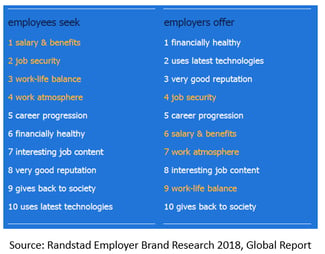Reading time: 2 minutes

Tired of poor workforce management in your organization? Good news: you’re not alone. One writer even goes so far as to make the claim that “if you’ve never felt overworked at some time in your career, you probably don’t have a pulse.”
Regardless to how much of poor workforce management we have ever encountered, there is a solution to the problem!
Expectations vs. Reality
 According to Randstat’s Employer Brand Research 2018, employees list having a work-life balance as 1 of top 3 things they seek from their workplace. A divergence surfaces however, when contrasted to what they perceive their employers offer, where they ranked work-life balance at 9 out of 16.
According to Randstat’s Employer Brand Research 2018, employees list having a work-life balance as 1 of top 3 things they seek from their workplace. A divergence surfaces however, when contrasted to what they perceive their employers offer, where they ranked work-life balance at 9 out of 16.
That said, having a work-life balance is more than just about the hours; it is also about encompassing a flexible and healthy workplace culture that allows employees to balance productivity and engagement.
Hence, underlying this tough balance is the call for stable workforce management structure that avoids a skew towards to either over or under-working employees. Here, stability here does not automatically translate into being static. After all, who is to say that a stable workforce management structure cannot be dynamic at the same time?
Workforce Management from the Employees’ Perspective
Sure, having a stable workforce management structure is important for every organization, but what is its true cost? Are you bearing unnecessary costs of having a poor structure in place?

Being at the direct receiving end of any changes in workload, especially if done on a perpetual basis, employees can thus be negatively affected in more ways than one. To list, there are 3 common points of dissatisfaction:
- having irregular and erratic schedules,
- being overworked,
- being under-worked.
Nobody likes to be overworked and perhaps this does not come as a surprise, but employees also do not like to be under-worked or not actively engaged in their work. One of the consequences of having low engagement amongst workforce is presenteeism, for example, which is reported to cost US businesses $230 billion annually[1].
Since November 2017, it has been regulated that fast food companies in New York are required to inform all workers of their schedules 14 days in advance, and any changes made to the schedule within the 14 days would be compensated (via an extra fee) to the worker affected[2]. This was implemented as a response to the irregular schedules imposed by businesses (F&B, retail, etc.) in their bid to reduce labour costs when the recession hit. However, almost a decade on, advocates fought that it was high time for a change, given that the irregularity has taken a toll on the workforce, as many of them struggle to plan their lives around volatile, unstructured work schedules.
Having the right balance between workload and workforce is vital in fostering employee engagement and productivity in their work.
Benefits of a Stable Workforce Management
By establishing proper workforce management structure, this provides an air of professionalism which is also crucial amongst your employees. It reflects whether the organization knows what it is doing or not. With proper workforce structures in place, employees do not have to be kept wondering constantly on what would be coming next; they would be able to plan their schedules and also their work goals. Having a predictive workload offers a solution to alleviate challenges of imbalance; ensuring that employees work in the environment with optimal and satisfactory schedules.
Afterall, the unwavering fact remains that businesses are ultimately about its people; they are people before they are employees. Hence, it is imperative to remember that given the complexity of people, it is more important to provide a stable, dynamic, and clear workforce plan to meet the demands of your workforce. Because the perils of not having one, or the cost of overtaxing your workforce is, undeniably high. And every wise business leader would agree that it is an understatement.
[1] https://www.businessknowhow.com/manage/presenteeism.htm
[2] https://www.vox.com/videos/2017/12/4/16733326/low-wage-service-jobs



